The AMD Radeon R9 290X Review
by Ryan Smith on October 24, 2013 12:01 AM EST- Posted in
- GPUs
- AMD
- Radeon
- Hawaii
- Radeon 200
Company of Heroes 2
Our second benchmark in our benchmark suite is Relic Games’ Company of Heroes 2, the developer’s World War II Eastern Front themed RTS. For Company of Heroes 2 Relic was kind enough to put together a very strenuous built-in benchmark that was captured from one of the most demanding, snow-bound maps in the game, giving us a great look at CoH2’s performance at its worst. Consequently if a card can do well here then it should have no trouble throughout the rest of the game.
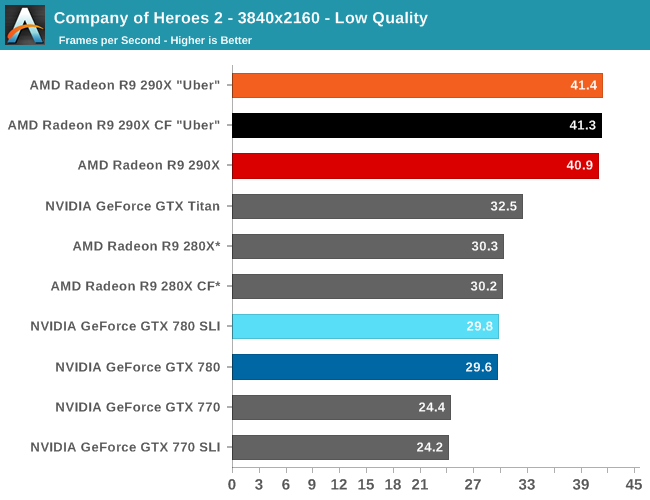
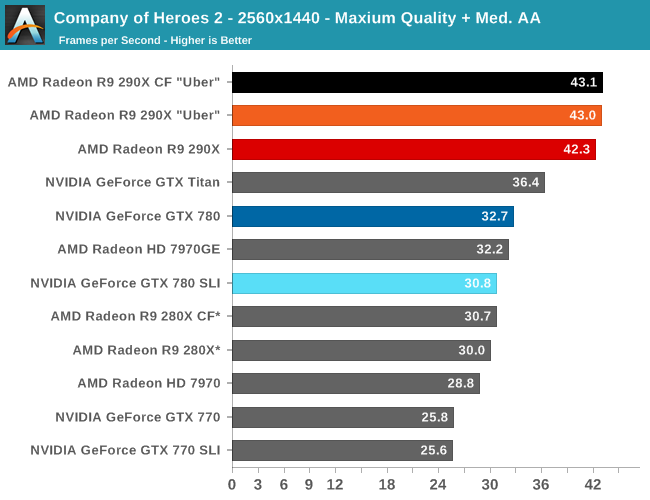
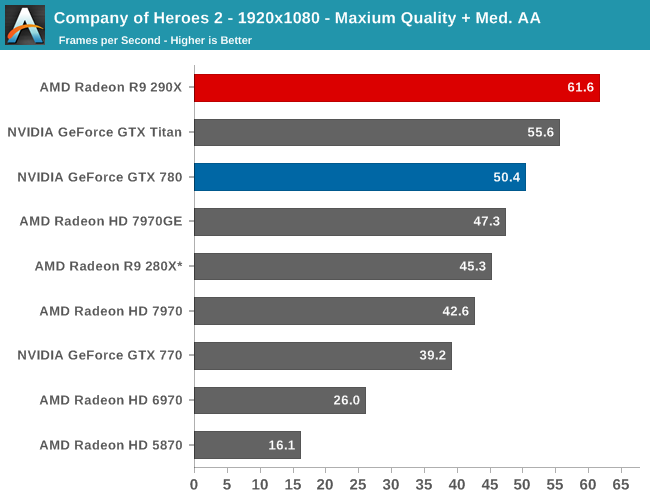
Our first strategy game is also our first game that is flat out AFR incompatible, and as a result the only way to get the best performance out of Company of Heroes 2 is with the fastest single-GPU card available. To that end this is a very clear victory for the 290X, and in fact will be the largest lead for the 290X of all of our benchmarks. At 2560 it’s a full 29% faster than the GTX 780, which all but puts the 290X in a class of its own. This game also shows some of the greatest gains for the 290X over the 280X, with the 290X surpassing its Tahti based predecessor by an equally chart topping 41%. It’s not clear what it is at this time that Company of Heroes 2 loves about 290X in particular, but as far as this game is concerned AMD has put together an architecture that maps well to the game’s needs.
Briefly, because of a lack of AFR compatibility 4K is only barely attainable with any kind of GPU setup. In fact we’re only throwing in the scale-less SLI/CF numbers to showcase that fact. We had to dial down our quality settings to Low on CoH2 in order to get a framerate above 30fps; even though we can be more liberal about playable framerates on strategy games, there still needs to be a cutoff for average framerates around that point. As a result 280X, GTX Titan, and 290X are the only cards to make that cutoff, with 290X being the clear winner. But the loss in quality to make 4K achievable is hardly worth the cost.
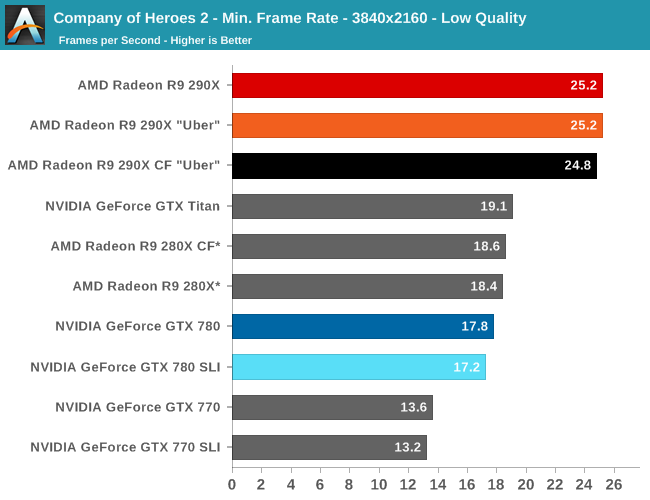
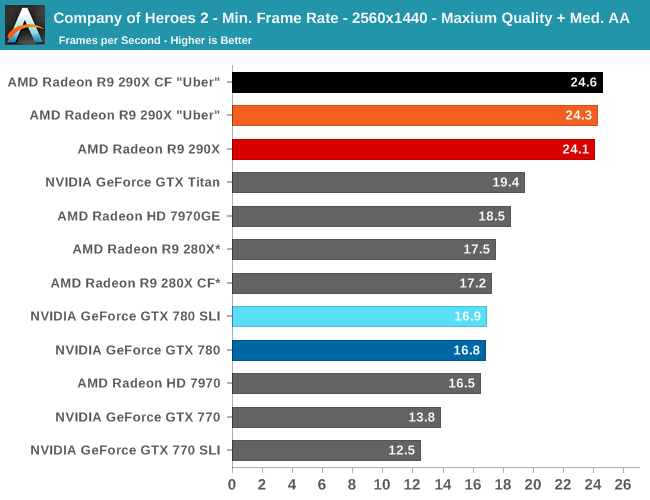

Moving on to minimum framerates, we see that at its most stressful points that nothing, not even 290X, can keep its minimums above 30fps. For a strategy game this is bearable, but we certainly wouldn’t mind more performance. AMD will be pleased though, as their performance advantage over the GTX 780 is only further extended here; a 29% average performance advantage becomes a 43% minimum performance advantage at 2560.
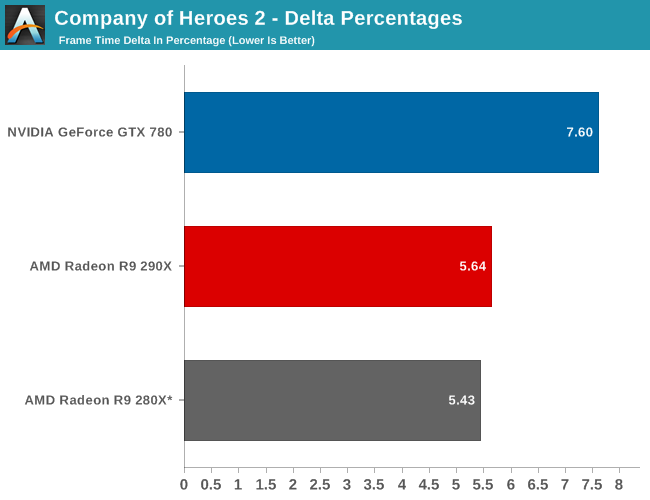
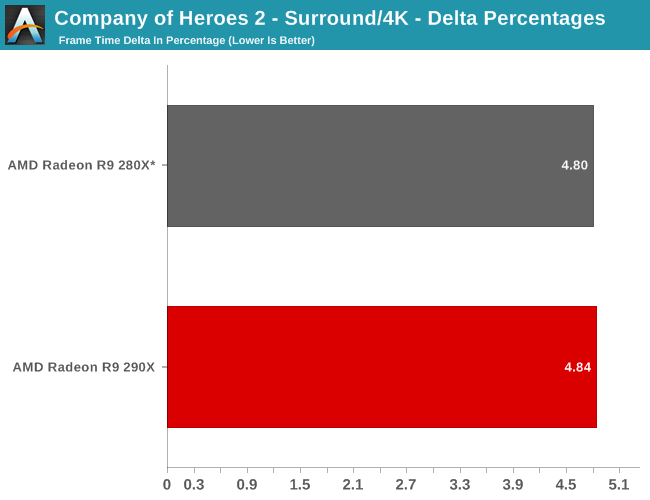
Finally, while we don’t see any performance advantages from AFR on this game we did run our FCAT benchmarks anyhow to quickly capture the delta percentages. Company of Heroes 2 has a higher than average variance even among single cards, which results in deltas being above 5%. The difference between 5% and 7% is not going to be too significant in practice here, but along with AMD’s performance advantage they do have slightly more consistent frame times than the GTX 780. Though in both the case of the 280X and the 290X we’re looking at what are essentially the same deltas, so while the 290X improves on framerates versus the 280X, it doesn’t bring with it any improvements in frame time consistency.










396 Comments
View All Comments
SolMiester - Monday, October 28, 2013 - link
There is no way Origin PC or any other OEM would want to put this reference card in there systems..I cant wait to see RMA stats with this card...AMD blew the card after such a great GPU...how many times will they do this?polaco - Saturday, October 26, 2013 - link
This is an interesting article too for gamers that are looking for 4K:http://www.legitreviews.com/amd-radeon-r9-290x-vs-...
dwade123 - Saturday, October 26, 2013 - link
All this shows is that GTX Titan is one efficient card. Better than both GTX 780 and AMD's offerings.ehpexs - Saturday, October 26, 2013 - link
Looks like AMD is a gen away from offereding a crossfire solution that can max out my triple crossovers @ 7680x1440Th-z - Sunday, October 27, 2013 - link
It seems AMD is pushing 290X really hard, to the point beyond its efficiency curve to try to win over larger chips with almost 1B more transistors from Nvidia. I wonder if reducing some ROPs and dedicate more die area to shader core may look like to 290X, or to go all in, designing a chip as large as Nvidia's top parts.Ytterbium - Sunday, October 27, 2013 - link
I'm sad they've gone to 1/8th FP, the 280X is a better compute card!Animalosity - Sunday, October 27, 2013 - link
Why can't people just accept that AMD has beaten Nvidia in every shape and form this time. Yeah, its always been back and forth. And it will again in the future, but for now AMD has the crown for everything except for power/sound levels. Keep in mind that not only does AMD own both next gen consoles, they are also running every one of these benchmarks on beta drivers which means that they will only continue to get better. Add mantle to the equation and Titan will have absolutely zero purpose in life. It was a good card. RIP Kepler.Vortac - Sunday, October 27, 2013 - link
Well, let's point out again that Titan has a much better FP64 performance, approx. 2.5x better than 290X, so "absolutely zero purpose" is not entirely correct. Of course, if you don't care about computing, then obviously 290X is a much better choice now.Luke7 - Sunday, October 27, 2013 - link
Are you talking about this?http://www.sisoftware.co.uk/?d=qa&f=gpu_financ...
Vortac - Sunday, October 27, 2013 - link
In this interesting review Titan is pitted against 7970 which has 1/4 FP64 performance and is indeed very good for double precision calculations, especially with OpenCL. 290X has 1/8 FP64 and its double precision performance is worse than 7970, leaving Titan with some space to breathe.